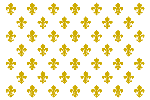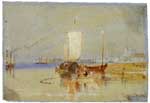
When the Bourbons returned in 1814 they brought back the White Flag with the semy de lys as national flag.
Anjou: Early 19th Century
The politics of the 19th century in France played out in the shadow of the Revolution. This was nowhere more true than in Anjou, because such strong loyalties lay on opposing sides. The return of the Bourbons (la Restauration) elicited great enthusiasm from the Catholic royalists, particularly in the Mauges and the Segréen.

|
When the Bourbons returned in 1814 they brought back the White Flag with the semy de lys as national flag. |
The sculpture of Angers' native son David d'Angers memorialized the heroes of the Revolution and expressed the progressive ideals of France. While David d'Angers had strong revolutionary loyalties, his works speak to the mood of reconciliation noticeable after 1825, when amnesty was granted to emigrés (those royalists and nobles who had left France during the Revolution). Read more about David d'Angers
Balzac, a native of neighboring province of Tours, wrote realistic novels considered a "peinture des moeurs" of the Restoration and July Monarchy. His work Eugénie Grandet (1833) is set in post-Revolutionary Saumur. Grandet has profited from the land reallotment of the Revolution and from the entrepreneurial possibilities of capitalism now available to his class of landed bourgeois. But the novel also alludes to the social hierachies of the capital, where nobility --often impoverished--enjoys enormous social status.
Read more about the Blue, White, and Red factions.

|
Joseph Turner, Saumur. |
CONSTITUTIONAL MONARCHY
LA RESTAURATION 1815-1830
LA MONARCHIE DE JUILLLET / The July Monarchy 1830-1848
The monarchy was marked by its overwhelming bourgeois character and strong Republican sympathies. The government alienated Royalists, but also failed to appease the workers, particularly artisans, who clamored for protections for their livelihood. In Anjou, it would be the ardoisiers who were prominent in agitation for rights during the second half of the century. Discontent from both Left and Right led to the Revolution of 1848.
IIe RÉPUBLIQUE / The Second Republic 1848-1852
In Anjou, in the elections held for l'Assemblée Constituante and the la Législative, voter turnout was extremely high, and party lines are clearly visible: les rouges (democrates-socialistes) carried Saumur and le Bauge, while the royalist party l'Ordre dominated in the other areas. The leading political figure in Angers was liberal catholic Frédéric de Falloux.

|
Joseph Turner, View of a barge on the Loire, looking west towards Nantes |
Distinctive barges, known as chalands or gabarres had been developed to navigate the shallow Loire waters, their designs probably owing something to the Viking boats that had ravaged the coasts in the 9th century. They were about 22 meters long, with a single mast of considerable height carrying a huge square sail and a smaller pennant above. The bows of the boat rose up to create a broad poop area, behind which the cargo was stored. A large rudder or piature minimised the effort of steering. Sailing uprive, the barges were entirely dependent on the wind and were forced to travel erratically in short bursts.
Steamers were in use on the Loire from 1822 to 1855, regularly travelling the route from Nantes to Angers. This unreliable transportation was supplanted by the railroad (le chemin de fer).

|
David d'Angers, Bust of Balzac |
Honoré de Balzac (1799, Tours - 1850, Paris)
 Frédéric Alfred Pierre, comte de Falloux
Frédéric Alfred Pierre, comte de Falloux
Homme politique français (Angers 1811-Angers 1886). Rallié au catholicisme libéral, député légitimiste de Segré (1846), il soutint la candidature de Louis Napoléon (1848), dont il obtint le ministère de l'Instruction publique et des Cultes (décembre 1848-octobre 1849). Cofondateur du parti de l'Ordre (1849), il élabora la loi sur l'enseignement qui porte son nom et qui fut votée sous son successeur. Député à la Législative (1849), il s'opposa à la politique du prince-président, fut arrêté lors du coup d'État du 2 décembre 1851, puis se retira en Anjou. (Académie française, 1856.) Ecrivain (Mémoires d'un royaliste éclairé, posth. 1888)
This page was meant to be viewed in frames. |
 Return to Return toAmelia Carr's Home Page |